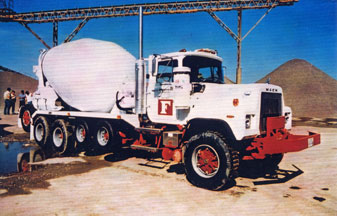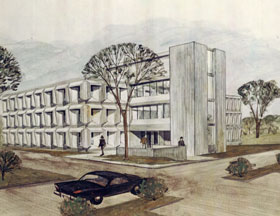Thanks to Steve Hedberg and the folks at the Beltline Industrial Park for information for this section. Please contact us with any additions or corrections.
The area now occupied by Target and Byerly’s along Highway 100 at 36th Street was used as a sand and block factory starting in 1913. Legend has it that Fred and Dorothy Hedberg were out on a horse and buggy ride and picnic. As he was always working, at the picnic site he stopped, took a shovel, dug a hole and said “This looks like good sand, I think I should have a plant here.” He was a house basement excavator. This account is supported by grandson Steve Hedberg, who owns Hedberg Landscape and Masonry Supplies.
The Hedberg-Friedheim Co. was incorporated by Fred Hedberg and Charles M. Friedheim, Sr. on March 28, 1922 with a capital stock of $50,000. The two had been businessmen and real estate investors on Lake Street, and Fred was producing concrete “small blocks” in one of his Lake Street properties. The two started their first block plant in Hopkins, and in October 1931, they purchased a site for a second plant in St. Louis Park. The company began manufacturing concrete blocks at the St. Louis Park site in 1931. Steve Hedberg adds that “Also black dirt & sand from the St Louis Park site when it began went to build many of the Minneapolis parks such as Theodore Worth Park.”
It was at the swimming hole at this site where, one sad day in May 1933, 11 year old Robert Forsythe drowned. The boy had gone swimming with four other boys in the pool, which a contemporary account described as 18 feet deep in places. Tom Renner remembers that there was a sand bar in the center of the pond, and when he went out to look for the boy, he stumbled on him there. The water was only about 2-1/2 feet deep, and to this day the boy’s death remains somewhat of a mystery. The Forsythe family had only moved to the Park a week before.
In 1943, the company was granted a 15-year permit to operate a gravel pit. Friedheim planned to level off his old site south of 36th St. A ready mix concrete plant was added in 1949. The site grew and grew, with Friedheim buying used mining equipment from the Iron Range. One particularly powerful vehicle was called the Euclid.
On December 23, 1952, Friedheim began to develop some of his vast holdings by creating the LaSalle Investment Company, which was incorporated with a capital stock of $40,000.
In 1953, Friedheim and Hedberg parted company. They reportedly didn’t get along – some say they didn’t speak to each other for the last five years of their partnership. A note on the abstract dated August 13, 1953 indicated that they would “conduct the winding up of the affairs of this corporation.” The land was transferred from Hedberg-Friedheim to Charles M. Friedheim on July 2, 1953.
Hedberg moved on to Edina, where he developed one of the company’s sites into Centennial Lakes. The company became Hedberg and Sons. Fred’s grandson Steve now owns Hedberg Landscape and Masonry Supplies.
Friedheim meanwhile started the Charles M. Friedheim Co., and hired Donald O. Johnson, a highly respected engineer from St. Paul, as President.
On June 29, 1954, the LaSalle Investment Company changed its name to the Belt Line Industrial Park. The land north of 36th Street was transferred from Friedheim to the Belt Line Industrial Center, Inc.
In 1960, the company built a sand and gravel operation in Osseo. Two years later a ready mix operation was built at the Osseo site, and in 1964, they started autoclave block production.
In 1960, Friedheim’s son, Charles M. Friedheim, Jr. became President of the firm. A newspaper article stated that Friedheim products were used in the construction of many recent Park buildings, including the Gambles Distribution Center, Archie Walker’s Imported Motors, the Ambassador Motel and Westinghouse.
In 1961, the Topps Discount Store chain was angling to buy the property at 3700 Highway 100, across the highway from the concrete plant. An elaborate civic center had been planned for the site, but the City was tempted to sell and use the proceeds to build somewhere else. There were numerous complaints, as the neighbors wanted to keep the store out of the area, but when Friedheim (and Ernie Jacobson from the dump) offered up their sites for the store, the City figured it might as well take the profit. That site became Topps, then Shoppers’ City, Kmart, etc.
Friedheim died in Florida on December 7, 1963 at the age of 73. His obituary cited frequent and sizeable contributions to nonprofit organizations through the years, including Big Brothers, the Chamber of Commerce, Optimists Club, and the Minneapolis YMCA. The article stated that he remained the company’s board chairman until his death. He was also owner and president of the Belt Line Industrial Park. At his death, the concrete block concern went to Charles Jr., and the land that would become the Beltline Industrial Park was left to his daughter Lucille.

In the 1960’s, the VFW used the site for their Fourth of July fireworks display.
In 1966, the plant included – in addition to the ready mix concrete plant – precast lintel manufacturing and colored patio tiles. Two local projects with Friedheim Autoclave masonry units were St. Luke’s Lutheran Church and St. Patrick’s School in Edina.
In 1970, the company announced that it would be phasing out its St. Louis Park operations and shifting to its Lakeville and Osseo plants. They unveiled a plan to build offices and apartments on its 40-acre St. Louis Park site, to be built over a period of 5-10 years at a cost of $20 million.
The origins of the Friedheim Building, 5115 W. 36th St. (now 3601 Park Center Blvd.) are a little murky. An addition was made to a building bearing that name and address in 1957. The building pictured below was built in 1970.

Charles Jr. was a respected member of the business community, active in the Masons, Rotary, and the Chamber of Commerce (which his father reportedly pulled out of the fire in 1957). With his wife Mildred he had three daughters, Kathryn, Suzanne, and Deborah. He died on November 14, 1977 of a heart attack. At the time of his death he lived at 6650 Vernon Ave. in Edina.
The site eventually became Byerly’s, “the world’s swankiest supermarket” in 1980. The store was built on grounds that had been used for storing block and dumping waste concrete, and the parking lot is stabilized with crushed waste concrete from the old dumping grounds.
The Friedheim Building was demolished in 2011 and is now a luxury apartment building called 36 Park.
